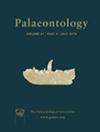水生鳄鱼后颅的有限收敛
IF 2.3
2区 地球科学
Q1 PALEONTOLOGY
引用次数: 0
摘要
Thalattosuchia(早侏罗世至早白垩世)和Dyrosauridea(晚白垩世至早始新世)是在河流和海洋环境中多样化并经历灭绝事件(即Thalattosuchia的侏罗纪-白垩纪边界;白垩纪-古近纪的龙总科)。在解剖学描述和诊断中,他们的后颅仍然被全球低估,掩盖了可能支撑他们的辐射和长寿的巨大适应。我们彻底调查了Dyrosauridea和Thalattosuchia的颅后形态,使用数十次高精度3D扫描在三维空间中重建了它们的腰带,并使用几何形态测量学分析了它们的形状。即使在相似的环境中发现,Dyrosauridea和Thalattosuchia也有明显不同的颅后颅骨,这表明进化支系特异性特征的存在限制了进化趋同的强度。此外,与现存的鳄鱼类相比,dyrosaurids和thalattosuchians进化出的后颅形态范围更大,使得后者在每一组灭绝的鳄鱼类中都不能提供令人满意的功能类似物。我们的工作揭示了颅后解剖学作为一个丰富的系统发育和分类特征的来源,以评估鳄鱼内的关系,以前没有预料到的潜力。因此,结合颅后解剖学对充分评估鳄形目的生态学、差异和关系显得至关重要。本文章由计算机程序翻译,如有差异,请以英文原文为准。
Limited convergence in the postcranium of aquatic Crocodylomorpha
Thalattosuchia (Early Jurassic to Early Cretaceous) and Dyrosauridea (Late Cretaceous to Early Eocene) are crocodylomorph archosaurs which diversified in fluvial and marine environments and endured extinction events (i.e. Jurassic–Cretaceous boundary for Thalattosuchia; Cretaceous–Palaeogene for Dyrosauridea). Their postcrania remain globally undervalued in anatomical descriptions and diagnoses, shrouding the locomotive adaptations that possibly underpinned their radiations and longevity. We thoroughly surveyed the postcranial morphology of Dyrosauridea and Thalattosuchia, recreated their girdles in three‐dimensions using tens of high‐precisions 3D scans, and analysed their shape using geometric morphometrics. Dyrosauridea and Thalattosuchia have clearly distinct postcrania, even when found within similar environments, suggesting the existence of clade‐specific features limiting the strength of evolutionary convergence. Moreover, the range of postcranial morphologies evolved by dyrosaurids and thalattosuchians is large compared to extant crocodylians, making the latter unsatisfactory functional analogues for every group of extinct crocodylomorphs. Our work reveals the previously unsuspected potential of postcranial anatomy as an abundant source of phylogenetic and taxonomic characters to assess the relationships within Crocodylomorpha. Incorporation of postcranial anatomy therefore appears crucial to fully assess the ecology, disparity, and relationships of crocodylomorphs.
求助全文
通过发布文献求助,成功后即可免费获取论文全文。
去求助
来源期刊

Palaeontology
地学-古生物学
CiteScore
5.60
自引率
3.80%
发文量
43
审稿时长
6 months
期刊介绍:
Palaeontology publishes a wide variety of papers on palaeontological topics covering:
palaeozoology
palaeobotany
systematic studies
palaeoecology
micropalaeontology
palaeobiogeography
functional morphology
stratigraphy
taxonomy
taphonomy
palaeoenvironmental reconstruction
palaeoclimate analysis and biomineralization studies.
 求助内容:
求助内容: 应助结果提醒方式:
应助结果提醒方式:


